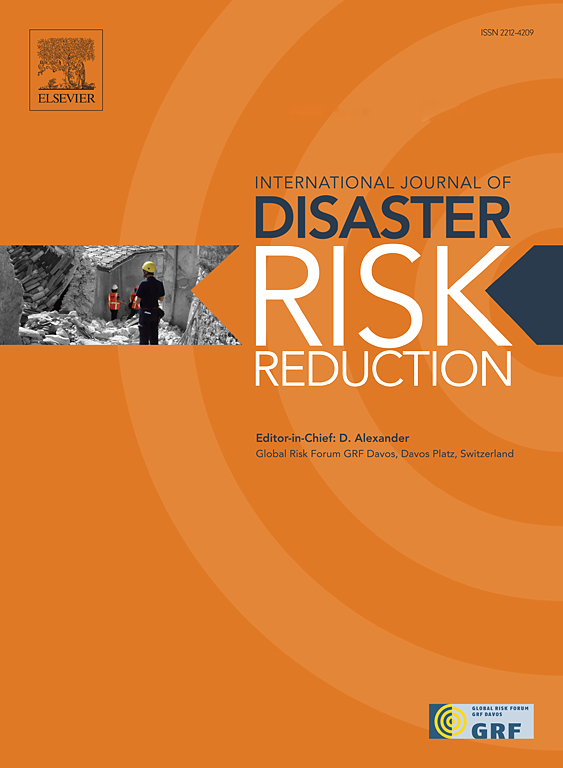Assessing the interrelationship between monsoon flood disasters and major crop production in Bangladesh
IF 4.2
1区 地球科学
Q1 GEOSCIENCES, MULTIDISCIPLINARY
International journal of disaster risk reduction
Pub Date : 2025-03-18
DOI:10.1016/j.ijdrr.2025.105401
引用次数: 0
Abstract
Bangladesh faces various acute and chronic natural calamities due to its precarious global positioning. Floods are among Bangladesh's leading and most frequent disasters. While much research has been published on the association between flood risk and agricultural losses, significant gaps exist in recognizing the relationship between monsoon flood disasters and agrarian land and production losses. This study aims to investigate the substantial crop losses brought on by monsoon floods, with a particular emphasis on the impacts of floods on crop productivity and strategies to mitigate those effects. It also describes the FAO method for assessing flood damage to the agricultural sector, concentrating mainly on flood damage to rice and jute crops. Both qualitative and quantitative methodologies were employed to collect and analyze the data for this study. Primary data was collected through interviews, structured questionnaires, personal observations, and informal discussions with 250 respondents. Secondary data was obtained from official records such as libraries, journals, yearly reports, statistics yearbooks, newspapers, and other relevant sources.
The combined quantitative and qualitative data revealed that flooding interrupts crop-growing patterns (rice, potato, pepper, and maize), decreases cropping land area, reduces crop production, and affects socio-economic conditions overall. In addition, this study focuses on the barriers and constraints that could obviate flood management. Hence, floods cause production losses of about 2.25 metric tons of rice and 2 metric tons of jute, equivalent to more than 50,000 ($600) and 45,000 ($550) BDT, individually. The study further recommended a monsoon flood management approach that prioritizes resilience and infrastructure development through constant surveillance and evaluation to ensure regional food security utilizing sustainable crop production. The crop damage assessment method described in this paper can also be applied in other areas for flood risk management.
孟加拉国由于其岌岌可危的全球定位,面临着各种急性和慢性自然灾害。洪水是孟加拉国最主要、最频繁的灾害之一。虽然关于洪水风险与农业损失之间关系的研究成果已经发表了很多,但在认识季风洪水灾害与耕地和生产损失之间的关系方面还存在很大差距。本研究旨在调查季风洪灾给农作物带来的巨大损失,特别强调洪灾对农作物生产力的影响以及减轻这些影响的策略。研究还介绍了粮农组织评估洪水对农业部门造成的损失的方法,主要集中于洪水对水稻和黄麻作物造成的损失。本研究采用了定性和定量两种方法来收集和分析数据。原始数据是通过访谈、结构化问卷、个人观察以及与 250 名受访者进行非正式讨论收集的。综合定量和定性数据显示,洪水中断了作物种植模式(水稻、马铃薯、辣椒和玉米),减少了种植面积,降低了作物产量,并影响了整体社会经济状况。此外,本研究还重点探讨了可避免洪灾管理的障碍和制约因素。因此,洪水造成的产量损失约为 2.25 公吨大米和 2 公吨黄麻,分别相当于 50,000 多美元(600 元)和 45,000 多美元(550 元)。研究还建议采取季风洪灾管理方法,通过持续监测和评估,优先考虑抗灾能力和基础设施发展,以确保利用可持续作物生产实现地区粮食安全。本文所述的作物损害评估方法也可用于其他地区的洪水风险管理。
本文章由计算机程序翻译,如有差异,请以英文原文为准。
求助全文
约1分钟内获得全文
求助全文
来源期刊

International journal of disaster risk reduction
GEOSCIENCES, MULTIDISCIPLINARYMETEOROLOGY-METEOROLOGY & ATMOSPHERIC SCIENCES
CiteScore
8.70
自引率
18.00%
发文量
688
审稿时长
79 days
期刊介绍:
The International Journal of Disaster Risk Reduction (IJDRR) is the journal for researchers, policymakers and practitioners across diverse disciplines: earth sciences and their implications; environmental sciences; engineering; urban studies; geography; and the social sciences. IJDRR publishes fundamental and applied research, critical reviews, policy papers and case studies with a particular focus on multi-disciplinary research that aims to reduce the impact of natural, technological, social and intentional disasters. IJDRR stimulates exchange of ideas and knowledge transfer on disaster research, mitigation, adaptation, prevention and risk reduction at all geographical scales: local, national and international.
Key topics:-
-multifaceted disaster and cascading disasters
-the development of disaster risk reduction strategies and techniques
-discussion and development of effective warning and educational systems for risk management at all levels
-disasters associated with climate change
-vulnerability analysis and vulnerability trends
-emerging risks
-resilience against disasters.
The journal particularly encourages papers that approach risk from a multi-disciplinary perspective.
 求助内容:
求助内容: 应助结果提醒方式:
应助结果提醒方式:


